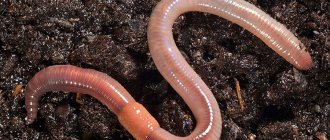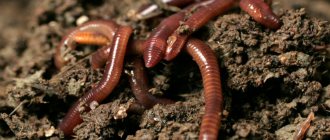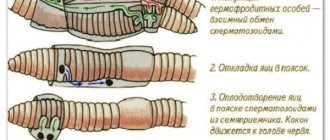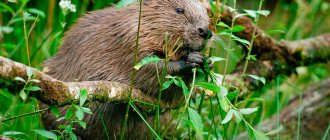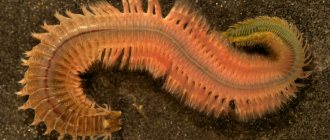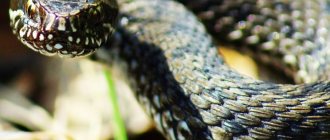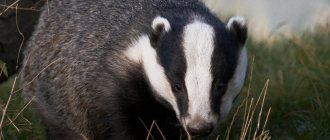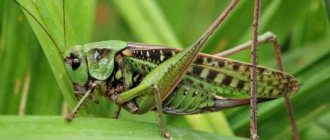Earthworm nutrition
This is a spineless omnivore. Earthworm organs
are designed so that they can swallow huge amounts of soil. Along with this, rotten leaves are used, everything except hard ones that smell unpleasant to the worm, as well as fresh plants.
The figure shows the structure of an earthworm
They drag all this food underground and begin to eat there. They do not like the leaf veins; the worms only eat the soft part of the leaf. It is known that earthworms are thrifty creatures.
They store leaves in their burrows as reserves, neatly folding them. Moreover, they may have a special hole dug for storing provisions. They fill the hole with food and cover it with a lump of earth. They do not visit their storage until necessary.
What leaf does Lupine have?
The leaves are alternate, palmately compound, on long petioles, articulated with the stem by a fleshy leaf pad with elongated stipules. The inflorescence is a multi-flowered apical raceme. The flowers are arranged alternately, semi-whorled or whorled. The flower is zygomorphic.
Interesting materials:
How to change an expired ID card online? How to change the layout in Metro Exodus? How to change the belt in an Indesit washing machine? How to change the rubber band in a washing machine? How to swap layers in Photoshop? How to change SMS to minutes in Beeline? How to change the theme in VK to your own? How to place a baby in an envelope in the Car Seat? How to wash a cat in the shower? How do you know if jeans are too big?
Comparison of annelids and roundworms, their similarities and differences
| Characteristic | Roundworms | Annelids |
| Symmetry | Double-sided | |
| Number of cells | Multicellular | |
| Digestive tract | Mouth, pharynx, intestines and anus | |
| Form | Non-segmental | Long body, divided into segments |
| Reproductive system | Dioecious | Hermaphrodites and dioecious |
| Nervous system | Pharyngeal ganglion with ventral and dorsal nerves | Peripharyngeal ring with ventral nerve cord |
| Circulatory system | No | Closed |
| Excretory organs | Through intracavitary fluid and tubules | Metanephridia |
| Body cavity | Primary | Secondary |
Also, roundworms in their life cycle often use intermediate hosts for full development. This is not typical for annelids. Annelids differ from roundworms by the presence of a closed circulatory system, represented by ventral and dorsal vessels.
Benefit
When we see a blooming garden, we understand that to some extent it is thanks to earthworms that enrich the soil with nutrients. These creatures process organic matter in the soil, turning it into nutrients that are easily absorbed by plants.
When earthworms dig, they plow the soil at the same time, which allows roots to grow, allowing for healthy plant growth. Tilled soil absorbs water and holds it inside. In addition, air circulates better in such soil. The movements of earthworms bring nutrients found deep in the soil to the surface. Nutrients enter the upper layers of the soil, where they are easier for plants to absorb.
In addition to the benefits that earthworms bring to plants, they also serve as food for birds. In early spring, birds fly to gardens precisely in search of worms, because at this time of year there are still no fruits or seeds that could serve as food for them. If an earthworm is placed in a container that does not allow light to penetrate, it will live in it for about two weeks, provided that peat moss is first placed in the container.
There are millions of earthworms. They are divided depending on their properties and location. They can be divided into: earthworms, red worms, field worms, nightworms and red hybrids. In one garden you can find several varieties of worms.
Earthworms come in a variety of colors and sizes. Their color is characterized by shades of gray, black, red or red-brown. Their length, as a rule, is 5 - 31 cm. And in some cases you can find worms of incredible length of about 370 cm, such as individuals living in Australia. Moist soil rich in nutrient-rich organic matter is ideal for worms.
Earthworms feed on insects, rotting animal carcasses, manure, lettuce and watermelon rinds. In most cases, earthworms avoid alkaline and acidic substances. However, their food preferences depend on their species. Nightworms, as their name suggests, scavenge for food from the surface after dark.
the remains of herbs and organic matter make up the diet of the worms. Having discovered food, they begin to dig in the ground, holding the food they find in their mouths. Worms really like to combine food with soil. Many earthworms, such as red worms, crawl to the surface of the soil in search of food.
Gardeners can help earthworms thrive by adding organic matter to the soil. When the organic content of the soil decreases, earthworms go in search of other soil with more favorable conditions, otherwise they will simply die. Proteins from the remains of worms are converted into nitrogen and feed plants. However, this benefit is very short-lived. The death of earthworms implies a deterioration in the condition of the garden, such an important role they play in nourishing the soil.
Earthworm or earthworm. schizoform
Varieties of earthworm
The earthworm group consists of many subspecies and families . Currently, more than two thousand species can be identified that are found in all regions of our globe. 40 of them live on the European continent. The most popular are two main types: the common earthworm and the dung worm. Let's look at the detailed characteristics of both varieties.
- The common earthworm grows up to 30 centimeters in length and has a brown or red body. It can live in human gardens and vegetable gardens, fields and forests. Capable of digging deep holes in the ground that reach three meters in depth. It is found almost everywhere where there is moist soil enriched with organic matter.
- The dung worm is smaller than its predecessor and has a length of 4 to 14 centimeters. The body is rusty in color with characteristic yellow stripes around the rings. From the name you can understand that the worm prefers places with a high content of compost substances, in other words - in manure. To survive, this animal needs soil with ready-made organic material and temperatures from 15 to 25 degrees Celsius.
Earthworms may also differ in biological properties, such as type of nutrition and habitat in the soil. For this reason, scientists distinguish two main varieties:
- Whale shark
- 34 facts about raccoons
- Maned wolf
- Nettle
- Elk
- 100 facts about bears
- worms that live on the surface of the soil;
- worms that dig deep holes and make homes inside the soil.
Transporting oxygen cells
Oxygen cells in vertebrates carry hemoglobin from the respiratory organs. In the blood of earthworms, a substance similar in composition also brings oxygen to all cells of the body. The only difference is that worms do not have respiratory organs. They “inhale” and “exhale” through the surface of the body.
The thin protective film (cuticle) and epithelium of the worm's skin, together with the large capillary network of the skin, guarantee good absorption of oxygen from the air. The capillary web is so large that it is even found in the epithelium. From here, the blood moves through the wall vessels of the body and the transverse vessels into the main stem channels, due to which the entire body is enriched with oxygen. The reddish tint of the body of this ringed species is given precisely by the large capillary network of the walls.
Here you need to take into account that the thin film covering the earthworm’s body (cuticle) is very easily moistened. Therefore, oxygen first dissolves in water droplets, which are held by the skin epithelium. It follows from this that the skin should always be moisturized. Thus, it becomes clear that environmental humidity is one of the important conditions for the life of these animals.
Even the slightest drying of the skin stops breathing. Because the earthworm's circulatory system does not bring oxygen to the cells. It cannot survive in such conditions for very long, using internal water reserves. The glands located in the skin help out. When the situation becomes really acute, the earthworm begins to utilize the cavity fluid, spraying it in parts from the pores located on the back.
Digestive system
Internal structure of an earthworm.
Digestive, nervous, circulatory system of an earthworm. The mouth is located at the anterior end of the earthworm's body; the anus is on the back.
The earthworm feeds on rotting plant debris, which it swallows along with the soil. It can also drag fallen leaves from the surface. Food is swallowed as a result of contraction of the muscles of the pharynx. The food then enters the intestines. Undigested remains, along with soil, are expelled through the anus at the rear end of the body.
The intestines are surrounded by a network of blood capillaries, which ensures the absorption of nutrients into the blood.
Body symmetry
Unlike Hydra and many other coelenterates, the body of the earthworm exhibits clearly defined bilateral symmetry of the body. In animals with this structure, the body is divided into two identical halves, right and left - the only plane of symmetry that can be drawn along the main axis of the body from the mouth to the anus. Bilateral symmetry is characteristic of worms and many other animals.
The transition of worms from radial symmetry of the body, characteristic of their ancestors - coelenterates, to bilateral symmetry is explained by their transition from a swimming or sessile lifestyle to crawling, to a terrestrial lifestyle. Consequently, the development of different forms of symmetry in multicellular animals is associated with changes in the conditions of their existence.
Charles Darwin wrote in 1881 that archaeologists should be grateful for the preservation of many ancient objects precisely to earthworms, under whose excrement coins, jewelry, and stone tools were safely stored for many centuries. In addition, the great naturalist established that in a few years the worms pass the entire arable layer of soil through their bodies, and their countless burrows form a kind of capillary network of the earth, providing its ventilation and drainage.
There are a huge number of earthworms on Earth: about 6,000 species. They live on all continents except Antarctica.
There are especially many of them in the tropics. An adult earthworm can reach a length of 15 cm; in the tropics, 3-meter individuals are found.
Lumbricus terrestis spends its entire life in the ground, tirelessly digging tunnels. They usually appear on the surface during rains due to lack of oxygen and at night.
The body of the worm consists of several tens, or even hundreds of segments (80 - 300). When moving, it relies on bristles, which are present on all segments except the first. Characterized by a closed circulatory system. The blood is red. There is one vein and one artery running through the entire body. Breathing is carried out over the entire surface of the body, which is covered with mucus. The nervous system is represented by two nerve ganglia (brain) and the abdominal chain. Capable of regeneration. Earthworms are hermaphrodites, that is, each sexually mature individual has a male and female reproductive system. Cross fertilization is common.
Photo: internal structure of the digestive system of earthworms.
Reproduction of earthworms.
Video: The principle of shedding the cocoon of an earthworm.
The structure of an earthworm: digestive, nervous and circulatory systems.
Video: Earthworm movement
An earthworm's burrow is a long channel that, on a hot summer day, descends to a depth of 1.5 meters. They feed on soil, fallen leaves and the remains of herbaceous plants. Penetrating the soil with their numerous passages, they loosen it, mix it, moisten it and fertilize it. During the day, the earthworm passes through itself an amount of organic substances equal to its body weight. If the soil is loose, then Lumbricus terrestis tears off a piece of soil with its lips and swallows it; if it is dry, it moistens it with saliva.
Composting organic materials
Composting is a mandatory technological operation during which complex biochemical (enzymatic) processes of decomposition of plant residues occur. For example, fiber, a complex polymer of sugars, breaks down into monosaccharides that are easily digestible by any microorganisms; proteins of complex amino acid composition break down into amino acids, which are also necessary for the synthesis of proteins of living and reproducing bacteria; ammonia nitrogen from urea, uric acid and other nitrogen-containing products excreted by animals is decomposed to ammonia in the form of products that are easily digestible by nitrophytic thermophilic bacteria; animal and vegetable fats are broken down into fatty acids necessary for the life of microbial associations and soil zoofauna. During composting, a high temperature rises in the decomposing material, which is destructive for weed seeds, spore forms of pathogenic bacteria, helminth eggs, nematodes, soil fungi, etc., while at the same time especially favorable conditions are created for the development of soil thermophilic nitrogen-fixing microflora. In the decomposing organic matter, the process of formation of animal protein (microbial biomass) and humus occurs.
Compostable materials thus become accessible, easily digestible food for the soil animal community. The main and most numerous species among this community are earthworms. Compost is intended to feed them.
Composting of organic-containing materials occurs only in piles. Many peasants and owners of personal plots compost organic waste in so-called compost pits. However, this is not composting, but ensiling (a completely different biochemical process associated with the formation of acidic decomposition products).
In order for the pile to be sufficiently saturated with air, its height must be 1.5...2 m. The pile is laid in the form of a pyramid or, if there is a lot of organic matter, in the form of a triangular prism.
To prevent heat loss and ensure conditions for the occurrence of biothermal processes in the surface layers of the mixture, it is better to cover the piles with prepared compost 5...20 cm thick in the summer and 30...40 cm in the winter.
When laying a pile of composted organic matter, you can add complex chemical fertilizers containing nitrogen, phosphorus and potassium (NPK) at the following rate: per 1 ton of composted materials add 2...3 kg of double superphosphate, 1 kg of potassium sulfate, 2...3 kg of ammonium sulfate, 1 kg of magnesium sulfate, 60 g of boric acid or sodium borate, 3...5 kg of ground gypsum (chalk, lime, dolomite flour). Potassium chloride and other chlorides should not be used. In the soil, they decompose with the release of chlorine and form organochlorine compounds - dioxins, which are very toxic and dangerous for all living things. All this must be distributed evenly over the surface of the collar. After this, you should moisten the pile well (up to 60% humidity) and cover it with an insulating layer of old compost or just a layer of earth. The composted mass begins to warm up, and after 5...7 days in summer the temperature inside the pile reaches 53°C and above, in winter - after 7...10 days.
The second main biological component (after microbial) in compost processing technology is the productive species of dung (compost) earthworm. This species is widespread and easily adapts to various organic-containing substrates.
The second feature of worm cultivation is associated with the danger of violating sanitary and veterinary rules that occur when buying and selling worms. Worms are animals and are subject to animal quarantine regulations when making a purchase or sale.
Newly emerged juveniles of process worms are distinguished from nematodes by the presence of a red spinal blood vessel running along the entire body, which is clearly visible.
The presence of a nematode in a substrate with technological worms is determined simply: it is necessary to place the test substrate in a loose form in a clean glass jar. If there are nematodes in it - white worms, 1...3 mm long, thin, like threads, stick to the glass and “wave” their tail end. They must be examined with a magnifying glass.
The third feature of technological worms that sellers and buyers should remember is their fairly strict adherence to feeding on a substrate of a certain recipe. Technological worms always painfully tolerate the replacement of one substrate with another, which is accompanied by their death or a sharp decrease in their productivity, even with such a seemingly insignificant replacement of one nutrient substrate (compost based on cattle manure) with another substrate (compost based on bedding manure from a neighboring calf barn ). The manure of calves fed with milk contains large amounts of protein. This protein is poorly (slowly) fermented (decomposed) when such manure is composted, which manifests itself in a toxic effect on worms that are not adapted to consume it.
An even greater risk of losing purchased worms arises when they colonize a completely foreign substrate, for example; compost based on pig, horse, chicken manure, etc. Their settlement is possible only with cocoons of future technological worms. Worms emerging from cocoons, with the first sip of food, receive information that configures their digestive system to process food only of a given component composition. This miracle of nature is akin to the appearance of immunity in an animal to the introduction of a foreign antigen into its body, for example, an anti-diphtheria vaccine or some other vaccine. After vaccination, as is known, a given organism becomes protected from diphtheria, measles or plague, etc. Likewise, newborn worms, having tasted their first food, become only consumers of it, and not of anything else. You need to know and remember this.
Re-adaptation of the digestive system of adult worms from one food to another is a painful process and is often associated with their death.
Features and habitat of earthworms
These creatures are considered to be oligochaete worms. The body of an earthworm has a wide variety of lengths. It stretches from 2 cm to 3 m. There are from 80 to 300 segments. The structure of the earthworm is unique and interesting.
They move with the help of short bristles. They are on every segment. The only exception is the anterior ones, which have no bristles. The number of bristles is also not unambiguous, there are eight or more of them, the number reaches several dozen. Worms from the tropics have a larger number of bristles.
As for the circulatory system of earthworms, it is closed and well developed. Their blood color is red. These creatures breathe thanks to the sensitivity of their skin cells.
The skin, in turn, has a special protective mucus. Their sensitive recipes are completely undeveloped. They have no organs of vision at all. Instead, there are special cells on the skin that react to light.
In the same places there are taste buds, smell and touch. Worms have a well-developed ability to regenerate. They can easily recover their backside after damage.
The large family of worms that we are currently talking about includes about 200 species. There are two types of earthworms. They have distinctive features. It all depends on lifestyle and biological characteristics. The first category includes earthworms that find food for themselves in the ground. The latter get their food from it.
Worms that get their food underground are called litter worms and are found under the soil no deeper than 10 cm and do not go deeper even when the soil freezes or dries out.
Soil worms are another category of worms. These creatures can sink a little deeper than the previous ones, by 20 cm. For burrowing worms that feed under the soil, the maximum depth starts from 1 meter and deeper.
Burrow worms are generally difficult to notice on the surface. They almost never appear there. Even during mating or feeding, they do not completely protrude from their burrows.
The life of a burrowing earthworm, from beginning to end, passes deep underground in agricultural work. Earthworms can be found everywhere, except in cold arctic places.
Burrowing and bedding worms are comfortable in waterlogged soils. They are found on the banks of reservoirs, in swampy areas and in subtropical zones with a humid climate. The taiga and tundra are loved by litter and soil-litter worms.
And the soil is best grown in steppe chernozems. They can adapt in all places, but earthworms feel most comfortable in the soil of coniferous-broad-leaved forests. In the summer they live closer to the surface of the earth, and in the winter they descend deeper.
Appearance on soil
Earthworms are best known for crawling out of their burrows onto the ground surface en masse after heavy rains. Because of this, they are called rain. It is not known for certain why this happens, but there are opinions that the following factors may contribute to this:
To read: What are mice afraid of and why: smells and sounds
- They seek warmth as precipitation causes the temperature inside the soil to drop several degrees.
- They need oxygen and moisture, which become more abundant in the upper soil layers after rain.
- Worms move to a new place, and it is much more convenient to do this on a moistened surface. Dry soil injures them, friction causes severe injuries to invertebrates, even if they move at low speed.
- Rain makes the soil more acidic, and the worms are forced to temporarily get out so as not to die in an unsuitable environment for them.
- Worms are afraid of the sound of rain, because the vibration it creates is reminiscent of the sounds of the approach of their direct natural enemies in the food chain - moles. This feature is used by experienced fishermen who need earthworms as bait. They insert a stick with an iron sheet attached to it into the ground and begin to swing it strongly in different directions. Due to this, vibration is created, under the influence of which invertebrates quickly crawl out of their holes. This is where people collect them.
Natural necessity
All animals have a circulatory system, starting with secondary cavities. It was formed as a result of an increase in vital activity (compared, for example, with Life in constant motion requires stable energetic muscle work, which, in turn, causes the need for an increase in the cells of incoming oxygen and nutrients, which only blood can deliver.
What is the circulatory system of an earthworm? The two main arteries are the dorsal and the abdominal. In each segment, looped vessels pass between the arteries. Of these, several are slightly thickened and covered with muscle tissue. In these vessels, which perform the work of the heart, muscles contract and push blood into the abdominal artery. The annular “hearts” at the exit into the spinal artery have special valves that prevent blood flow from going in the wrong direction. All vessels are divided into a large network of thin capillaries. Oxygen comes from the air, and nutrients are absorbed from the intestines. Capillaries located in muscle tissue release carbon dioxide and breakdown products.
The circulatory system of the earthworm is closed, since during the entire movement it does not mix with the fluid of the cavity. This makes it possible to significantly increase the metabolic rate. In animals that do not have a blood pumping system, heat transfer is two times lower.
The nutrients that the intestines absorbed during the movement of the worm are distributed through a well-formed circulatory system.
Its scheme is quite complex for this type of animal. Vessels run above and below the intestines along the entire body. The vessel running in the back is equipped with muscles. It contracts and stretches, pushing blood in waves from the back to the front of the body. In the anterior segments (in some species of worms it is 7-11, in others - 7-13), the vessel running along the back communicates with several pairs of vessels running transversely to the main one (usually there are 5-7). The circulatory system of an earthworm imitates hearts with these vessels. Their muscles are much more developed than others, so they are the main ones in the entire system.
How to use vermicompost
Humus contains a mobile (water-soluble) fraction of humates: lithium, potassium and sodium humates. These are the most valuable humates for any plants. They are absorbed by plants first of all. These humates, even at very low concentrations, stimulate seed germination, plant growth and development, promote the formation of chlorophyll, enhance photosynthesis, and supply mineral salts from the soil to plants.
It has been proven that soluble humates are non-toxic, non-carcinogenic, non-mutagenic, non-teratogenic and do not have embryological toxicity. No residual amounts of humates are found in plants. These are environmentally friendly products of processing plant residues, created by nature itself using natural technology and intended by nature as a specific product for the entire plant world.
As many researchers emphasize, physiologically active humic substances increase the utilization rate of mineral fertilizers. They recommend using them in a mixture with mineral fertilizers or against their background. With this combined use of liquid humates, the yield increased in field and laboratory experiments by more than 25...35%.
Along with an increase in yield, researchers noted a reduction in ripening time and an improvement in product quality (increased content of proteins, sugars, carotene, and oils in oilseeds).
The action of humates is especially effective in the initial period of plant development and during the period of greatest tension in biochemical processes, as well as when the external conditions of plant growth deviate from the norm, during drought and frost, excess nitrogen in the soil, oxygen starvation, etc. Under the influence of humic substances in The soil undergoes an accelerated process of decomposition of poisons that have entered it, and their accumulation in plant agricultural products decreases.
Thus, humates should be considered as substances that help reduce the amount of various poisons both in the soil and in plant products, which is especially important in connection with the problem of biosphere pollution and excessive chemicalization of agricultural production.
In the Central regions of the Non-Black Earth Region, in Siberia and the Far East, due to possible unfavorable meteorological conditions, an important task is to find a way to reduce the ripening period and the timing of mass harvesting of vegetables by 10...15 days. This problem, as studies have shown, can be solved with the widespread use of vermicompost. The use of it and other liquid humic preparations in agricultural production can expand the geographical boundaries of growing vegetables and a number of heat-loving plants in colder geographical zones.
The structure of earthworms
The structure of earthworms is quite simple. The length of individuals that are common in Russia varies from 2 to 30 centimeters. The entire body is divided into segments, there can be from 80 to 300. The earthworm moves with the help of very small bristles, which are located on each segment of the body, with the exception of the very first. There can be from 8 to 20 setae on one segment.
In the attached picture you can visually observe the structure of the worm. You can determine the front part of the worm, where the mouth is, and the back part, where the anus is located. You can also notice segments.
Earthworms are characterized by a closed circulatory system, which is quite well developed. It includes one artery and one vein. The worm breathes thanks to very sensitive skin cells. The skin contains protective mucus, which contains a large number of antiseptic enzymes. The brain is poorly developed. It consists of only two nerve ganglia. It is very common for worms to exhibit the ability to regenerate. For example, if you cut off his tail, after a while it will grow back.
The structure of an earthworm
Earthworms are hermaphrodites, each having both male and female reproductive organs. Reproduction occurs through the mating of two individuals. The genital organ of worms is a girdle; in size it occupies several anterior segments. The genital girdle is clearly visible on the body of the worm; it looks like a thickening. In this organ, the cocoon matures, from which small worms hatch after 2-3 weeks.
Reproduction and development
Earthworms are hermaphrodites. During the process of copulation of two individuals, mutual fertilization occurs, that is, the exchange of male gametes, after which the partners separate.
The ovaries and testes are located in different segments at the anterior end of the body. The location of the reproductive organ system is shown in Figure 51. After copulation, a belt is formed around each worm - a dense tube that secretes the cocoon shell. The cocoon receives nutrients that the embryos will subsequently feed on. As a result of the expansion of the rings located behind the cocoon, it is pushed forward to the head end. At this time, 10-12 eggs are laid through the opening of the oviduct into the cocoon. Further, when the cocoon moves, sperm from the sperm receptacles received from another individual during copulation enters it, and fertilization occurs. After this, the cocoon slides off the worm and its holes quickly close. This prevents the eggs contained in it from drying out.
The development of earthworms is direct, that is, they do not have larvae; a young worm hatches from the egg.
Character and lifestyle of the earthworm
Most of the life of these spineless creatures is spent underground. Why earthworms
are they most often found there? This keeps them safe. Networks of corridors at various depths are dug underground by these creatures.
They have a whole underground kingdom there. Mucus helps them move even in the hardest soils. They cannot be under the sun for a long time; for them it is like death because they have a very thin layer of skin.
Ultraviolet radiation poses a real danger to them, so the worms are mostly underground and only crawl to the surface in rainy, cloudy weather.
Worms prefer to be nocturnal. It is at night that you can find large numbers of them on the surface of the earth. Originally earthworms in the soil
They leave part of their body in order to reconnoiter the situation and only after the surrounding space has not frightened them in any way do they gradually go outside in order to get food for themselves.
Their body can stretch perfectly. A large number of the worm's bristles curve back, which protects it from external factors. It is almost impossible to pull out a whole worm without tearing it because, for the purpose of self-defense, it clings to the walls of the burrow with its bristles.
Earthworms sometimes reach quite large sizes
It has already been said that the role of earthworms
for people it is simply incredible. They not only improve the soil and fill it with useful substances, but also loosen it, and this helps saturate the soil with oxygen. In winter, in order to survive in the cold, they have to go deeper so as not to experience frost and hibernate.
They sense the arrival of spring by the warmed soil and rainwater that begins to circulate in their burrows. With the arrival of spring, the earthworm crawls out
and begins his labor agrotechnical activities.
Enemies
At any time of the day, on the lawn or in the clearing you can see a starling or a blackbird and a songbird, who, with their heads bowed, listen to see if there is a worm nearby underground. However, a caught earthworm can defend itself. The bristles on its body and powerful circular and longitudinal muscles help the rain worm stay in the ground.
Especially large and strong earthworms sometimes manage to escape from a bird's beak. Sometimes only a piece of an earthworm remains in the bird's beak. If this is the back part of the worm's body, then the animal usually survives and grows back the lost part of the body. Ordinary worms become prey for hedgehogs, badgers, foxes and even wolves. However, their main enemy is the mole, which also lives underground.
Description
Earthworms or earthworms (lat. Lumbricina) are a suborder of oligochaete worms from the order Haplotaxida. They live on all continents except Antarctica, but only a few species initially had a wide range: the spread of a number of representatives occurred due to human introduction. The most famous European earthworms belong to the family Lumbricidae.
The body length of representatives of different species varies from 2 cm (genus Dichogaster) to 3 m (Megascolides australis). The number of segments is also variable: from 80 to 300. When moving, earthworms rely on short bristles located on each segment except the anterior one. The number of bristles varies from 8 to several dozen (in some tropical species).
The circulatory system of worms is closed, quite well developed, and the blood is red. Breathing is carried out through the skin, rich in sensitive cells, which is covered with protective mucus. The nervous system of earthworms consists of a poorly developed brain (two nerve ganglia) and an abdominal chain. They have a developed ability to regenerate.
Earthworms are hermaphrodites; each mature individual has a female and male reproductive system (synchronous hermaphroditism). They reproduce sexually using cross-fertilization. Reproduction occurs through cocoons, inside which the eggs are fertilized and develop. The cocoon occupies several anterior segments of the worm, standing out relative to the rest of the body. Small worms emerge from the cocoon after 2-4 weeks, and after 3-4 months they grow to the size of adults.
The food consumed by earthworms is first ground up in their throats and then passed into the intestines. Here the digestive process takes place with the help of enzymes. Some of the food is aimed at providing the worms with energy and promoting their growth. The rest of the food is excreted in the form of granules. The soluble nutrients in these pellets are more beneficial than the food the worms consume in the first place. These secretions are rich in calcium, magnesium, phosphorus and nitrogen.
In winter, earthworms hibernate. Due to the fact that frosts instantly kill earthworms, they prefer to burrow deeper into the ground, where frost does not penetrate. In the spring, when the temperature reaches a suitable level and the ground is saturated with rainwater, earthworms become very active. At this time, mating season begins for them.
They reproduce very quickly, producing about a hundred young worms per year. In summer, worms are not as active. There is very little food at this time, and the soil is deprived of moisture, which can cause the death of the worms. The autumn period is again characterized by worm activity. At this time, reproduction of offspring begins again, which lasts until the onset of winter.
Earthworms live relatively long. Some manage to live for about ten years if they do not become victims of birds and moles. Another threat to their life is the pesticides that are so widely used in gardening today. Some worms die due to extreme heat or frost. Worms can also die when the soil becomes dry or when there is not enough food. All these conditions shorten the lifespan of earthworms, which are the best helpers for gardeners.
Earthworm or earthworm.
Life cycle
The lifespan of an earthworm can be up to 10 years, but most often it averages 4-8 years. His cycle is well known to everyone from drawings, pictures and stories from biology textbooks, and consists of the following stages:
- Tiny worm larvae emerge from the cocoon. In these invertebrates, the process of incubation of eggs takes up to 2-8 weeks, and then the young generation emerges on the surface of the earth. If the air temperature is high for a long time, the worms will grow faster. With regular rainfall, it will take about 2 weeks for the eggs to mature. In regions with colder climates, this process will take approximately two months.
- Adult worms molt and mature. In the first weeks of life, they begin active development; a number of updates, new designations and changes occur in the reproductive system. Upon reaching one year of age, the worm is already capable of having its own offspring.
- At this stage, the need for reproduction is formed. Despite the fact that earthworms can be classified as hermaphrodites, they mate together. After copulation of two representatives of the species, a special shell is formed, inside which there is sperm. The process of fertilization occurs in each of the bodies.
- The last stage of the worm's life cycle is when they produce a natural cocoon. Upon completion of reproduction, the separation of individuals occurs. In both bodies, a cocoon of a certain pattern is formed, which then rolls into the ground and matures there. Each of them normally contains 1-5 embryos, which are then born.
